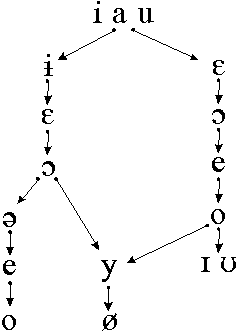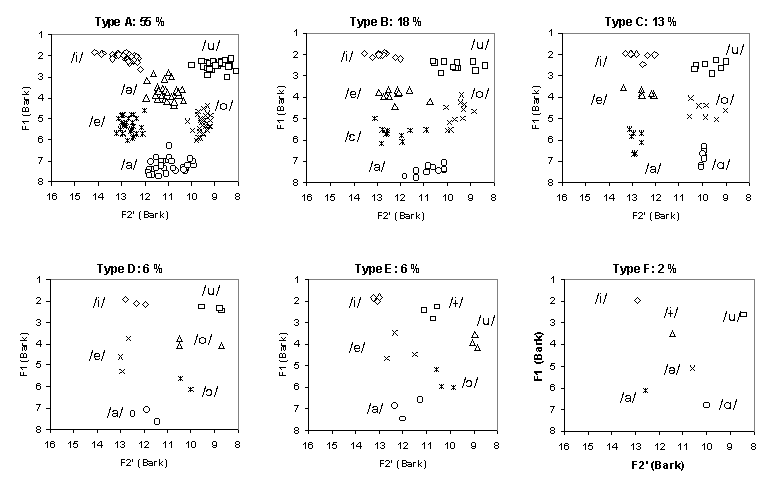
3rd Conference
The Evolution of Language
April 3rd - 6th , 2000
Abstracts
|
|
3rd Conference Abstracts |
![]()
AI-Lab
Vrije Universiteit Brussel
bartb@arti.vub.ac.be
The work described in this extended abstract is a continuation of the work that was presented at the previous evolution of language conference. I will start with a short recapitulation of the philosophy and hypotheses behind the "self organisation in vowel systems" simulation. In order to support the claims made, new results of the experiments on self-organisation and their relation to vowel systems in real human languages will be presented. But the goal of this abstract is slightly more ambitious (and speculative) than that. I will argue that a good understanding of the role of self-organisation is crucial when trying to explain language evolution. I will also argue (not without self-interest) that phonetics and phonology are ideal aspects of language for testing theories on the role of functional adequacy and self-organisation in explaining the evolution of language.
Explaining the evolution of language is a daunting task. Not only is language a very complex and multifaceted system, it is also a cultural phenomenon. This has several implications. Because of its many-sidedness, it will not be possible to find a single explanation or mechanism for the evolution of language. Because language is a cultural phenomenon, it is very hard (although not altogether impossible) to find evidence of its evolution. Furthermore, there will be cultural evolution and cultural variation of language co-occurring with its actual physical evolution.
However, this cultural aspect of language actually makes it possible to simplify the task of finding an evolutionary account for the origins of language. If we are able to separate the phenomena that can be explained through cultural mechanisms from the phenomena that must be explained by biological evolution, the complexity of the evolutionary account can be reduced. Cultural mechanisms will be subject to functional pressure. Forms of language that are difficult to learn, produce or process will be disfavoured with respect to forms of language that are easier. The importance of the link between functional factors and evolutionary processes has already been stressed by other researchers (e.g. Kirby 1999; Hurford, to appear). The importance of purely cultural mechanisms has been stressed by e.g. Steels (1998).
In reducing the amount of linguistic phenomena to be explained by evolution, we therefore have to look for possible functional constraints that are relevant to these phenomena. These phenomena might turn out to be emergent properties in the population due to the functional constraints. Emergence of phenomena in a population is often called self-organisation. The outcome of self-organisation is very hard to predict directly from the known constraints on the individuals in the population. The best way to test the influence of these constraints is therefore either to observe the population over a very long period of time (as in historical linguistics) or to build a computer simulation of the phenomena. Computer simulations are of course faster and easier to change. An extra advantage of computer simulations is that one can abstract away from unnecessary detail. If a certain phenomenon is observed even in a simplified computer simulation as the result of self-organisation in the population, it is likely that it will also be emergent in human language. Of course, computer simulations can only be used to test a theory. The real acid test for the theory is of course its ability to predict data from human languages.
The example that will be elaborated in this extended abstract is that of the properties of human vowel systems. Certain of these properties were caused by biological evolution. The shape of the vocal tract for example has clearly been determined by biological evolution. However, other aspects of vowel systems might not be determined biologically. The preferences for certain vowels over others, for symmetries and for certain inventory sizes are, according to some researchers (starting with Chomsky & Halle, 1968) due to biologically determined properties of the human brain. Other researchers (e.g. Liljencrants & Lindblom 1972) have proposed functional criteria for explaining these phenomena. In this extended abstract, and in previous papers (de Boer, 1999, to appear) I show that the combination of functional constraints and self-organisation is sufficient to predict the shape of vowel systems.
The computer simulation that was used to test the theory is based on a population of agents that are able to produce, perceive and store vowels in a human-like way. Production is based on an articulatory vowel synthesiser and perception is based on a distance function that uses the first formant and the effective second formant of the signal. The vowels are stored as prototypes. The interactions between the agents, so-called imitation games, consist of an agent picking a random vowel from its repertoire and producing it (imperfectly) with its synthesiser. Another random agent then imitates this sound, using its perception function, its list of vowel prototypes and its synthesiser. The first agent then checks whether the signal it perceives is analysed as the same vowel as the one it originally produced, and communicates the success or failure of the game using non-verbal feedback. The success of the game thus depends not only on the absolute qualities of the vowels used, but also on the repertoires of the agents that participate in the game. Depending on the outcome of the game, the agents update their repertoires by removing, adding, shifting or merging vowel prototypes, using only local information and a rather general learning mechanism (selectionism combined with hill-climbing). The agents and games are described in much more detail in (de Boer, 1999).


Assessing the realism of the vowel systems that emerge is best done by classifying them according to the same principles with which human vowel systems are classified. One can then check whether the emerged vowel systems show the same universal tendencies as human vowel systems. Crothers (1978) has made a study of human vowel systems and derived a list of universals from that. His universals can be represented as implicational universals, as shown in figure 2. An arrow in the figure indicates that if a human vowel system has a given vowel, it will also contain the vowels from which there are arrows pointing towards it.
An example of emerged vowel systems with five vowels is given in figure 3. These figures were made by creating 100 random populations with 20 agents. Then 25 000 imitation games were run, for a given parameter setting (15% acoustic noise). Then the populations with systems with five vowels that emerged were selected (there were 49 of such systems). From each population, a random agent was selected, and its vowel prototypes were plotted in the acoustic space consisting of the first formant and the effective second formant. The scales of the figures are logarithmic. Three different types of five-vowel systems emerge. The symmetric system appears in 88% of the cases, the system with more front vowels in 8% of the cases and the system with more back vowels in 4% of the cases. Except the rightmost systems, all emerged systems followed Crothers’ universals. Furthermore, the percentages of occurrence match very well with those of human vowel systems (as measured by Schwartz et al. 1997) 88%, 8% and 4% versus 89%, 5% and 5% (for 109 languages). Similar good fits were found for systems of 4–8 vowels. For systems of 3 vowels and for systems with 9 vowels, the fit was less good. In order to further illustrate this, the 54 emerged systems for six vowels are shown in figure 4. Percentages from (Schwartz et al. 1997) were type A 55% type B: 20%, type C: 5%, type D: 7% and type E 13% (of 60 6-vowel systems in their data).

Systems of different sizes were obtained by running the simulation with different settings for acoustic noise. The more noise, the fewer vowels a system would contain. A very strong universal for human vowel systems is a tendency towards systems with five vowels. It was checked whether self-organisation in a population also showed a tendency towards particular sizes. For this reason, the system was run for noise levels between 9% and 28%. Below 9% no more vowel systems with less than eight vowels emerged. Above 28% no vowel systems with more than two vowels would emerge. The histogram for the different sizes is given in figure 5. These numbers have been calculated with a perception function that was slightly different from the perception function that was used in the previous experiments. The original perception function contained a small bug. This bug resulted in size four occurring the most frequently. As can be seen in the figure, with the bug repaired, size five occurs most frequently. The peak is not so pronounced as for human vowel systems, but it does occur.
These results show that systems of basic vowels can be predicted very well as the result of self-organisation under constraints of perception and production, without recourse to specialised innate structures determined by biological evolution. Of course, for larger vowel repertoires and for consonants and syllables, other factors start playing a role. Nevertheless the research presented here is a good demonstration of the power of self-organisation in predicting real linguistic phenomena.
Unfortunately, implementing similar simulations for more complex sounds turned out to be more difficult than expected. Still, investigating the role of functional constraints and self-organisation in phonetics and phonology is a promising way for gaining more understanding of the emergence of language. More complex speech units, such as syllables and words show compositionality, just as sentences do, but in a more limited way. Furthermore, functional constraints in phonetics are physical, and have relatively little to do with what Kirby (1999) calls processing. We know relatively little about the way the human brain processes language. Building computer simulations and verifying their results in the case of syntax, although very interesting from a linguistic point of view, involves a relatively large number of uncertainties and arbitrary decisions. On the other hand, many aspects of phonetics and phonology are much easier to measure and to model, as they involve physical signals. Therefore realistic computer simulations are easier to build and verify in this case, as has been shown by the results in this paper. Self-organisation and phonetics are therefore promising means for investigating the origins of human language.
Chomsky, N. & M. Halle (1968) The sound pattern of English, MIT Press, Cambridge, Mass.
Crothers, J. (1978) Typology and Universals of Vowel systems. In Joseph H. Greenberg, C. A. Ferguson & E. A. Moravcsik (eds.) Universals of Human Language, Volume 2 Phonology, Stanford: Stanford University Press pp. 93–152.
de Boer, B. G. (1999) Self-organisation in vowel systems, PhD. thesis Vrije Universiteit Brussel.
de Boer, B. G. (to appear) Emergence of sound systems through self organisation. In C. Knight & J. Hurford (eds.) The evolution of language, Cambridge: Cambridge University Press.
Hurford, J. R. (to appear) Social transmission favours linguistic generalization. In C. Knight & J. Hurford (eds.) The evolution of language, Cambridge: Cambridge Univ. Press.
Liljencrants, L. & B. Lindblom (1972) Numerical simulations of vowel quality systems: The role of perceptual contrast. Language 48 pp. 839–862.
Kirby, S. (1999) Function, Selection, and Innateness: The emergence of Language Universals, Oxford: Oxford University Press.
Schwartz, J., L. Boë, N. Vallée & C. Abry (1997), Major trends in vowel system inventories. Journal of Phonetics 25, pp. 233–253
Steels, L. (1998) Synthesising the origins of language and meaning using co-evolution, self-organisation and level formation. In J. R. Hurford, M. Studdert-Kennedy & C. Knight (eds.) Approaches to the Evolution of Language, Cambridge: Cambridge University Press pp. 384–404.
![]()
Conference site: http://www.infres.enst.fr/confs/evolang/